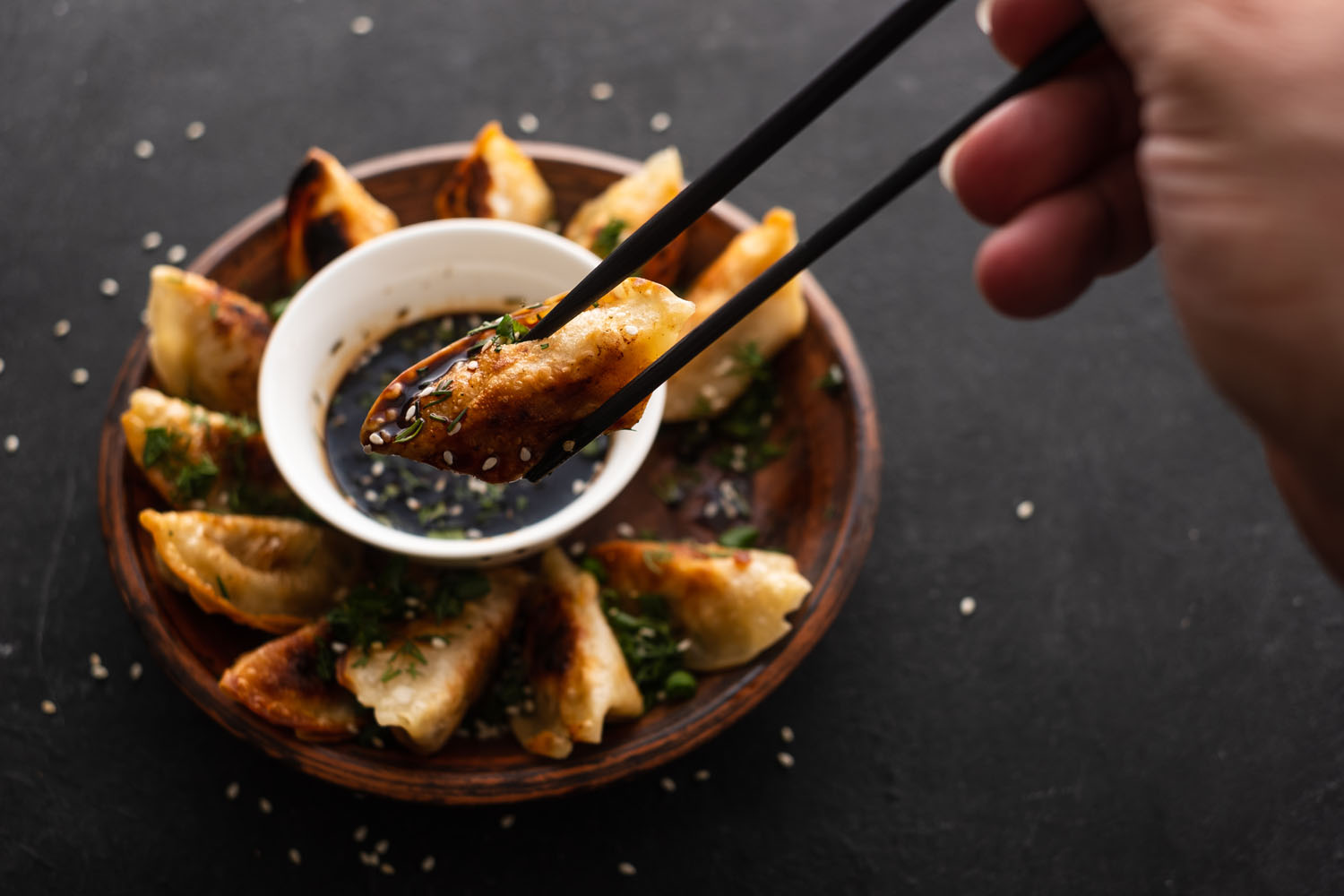

JAPANESE GYOZA DUMPLINGS IN 5 SIMPLE STEPS
Gyoza – Japanese or Chinese dumplings?
Just like many other Japanese dishes, gyoza come from traditional Chinese cuisine, where they are called jioazi. Although the dish is now permanently rooted in Japan’s tradition, the Japanese do not claim any rights to it, calling gyoza Chinese dumplings. Even the name of the dish refers to its homeland as it is written in katakana – the alphabet used for words of foreign origin.
Gyoza Japanese style slightly differ from those served in China, and their tradition is much shorter. During World War II, the Japanese occupying the areas of Manchuria would eat jioazi, that is crunchy dumplings with
a meat stuffing. Having returned to the country, the soldiers tried to recreate the recipe using the ingredients and techniques available in Japan. This led to the emergence of gyoza – Japanese dumplings made from slightly thinner dough, with more finely ground filling.
Gyoza – what is it?
In terms of appearance, the Asian dumplings resemble traditional Polish dumplings. Despite all the shared features, both the preparation and the way of serving considerably diverges from our national treats. First of all, Japanese dumplings come only savoury, usually with meat and vegetables. Aside from Western modifications (with banana and chocolate cream), dessert versions, resembling our fruit or sweet cheese dumplings, are not popular in Japan. Besides, gyoza are usually served as a a starter or a side with the main course rather than a separate dish. Although our dumplings tend to be refried or baked in the oven too to make the dough pleasantly crunchy, it is obvious for a Polish cook that they must be first cooked in hot water. Japanese, on the other hand, very often toss raw dumplings directly onto a frying pan. Gyoza can also be regularly cooked but they are much more often fried – also deep-fried – or steamed.
Japanese dumplings in 5 simple steps – a gyoza recipe
1. Knead the dough
All you need to prepare the dough for the dumplings is flour, hot water and salt. Put the flower into a big bowl, making a small hole in the middle. Slowly pour in boiling water, gently stirring the dough with a spoon. When the ingredients start to blend together, knead them with your hands for about 2 minutes. When ready, wrap the dough in cling film or cover with a damp cloth and put aside for at least 15 minutes. According to some recipes, the dough should be left for up to an hour. In the meantime, you can prepare the meat stuffing.
2. Prepare the stuffing
There are a thousand ways to prepare gyoza. Next to typically meat stuffing, you can come across vegetarian or seafood dumplings. But if you want to prepare the most traditional version, stuff them with minced pork with chopped napa cabbage, garlic, ginger and chives. Season the raw ingredients with miso paste, sesame oil, chilli pepper and salt. Give it a thorough stir and knead the stuffing with your hands.
3. Form rings made of the dumpling dough
Even if you have never prepared Christmas Eve dumplings yourself, your first impulse would probably be to grab a rolling pin and a glass to cut out rings from finely rolled out dough. The Japanese have another way of forming the dumpling circles, though. Divide the dough into several parts. Mould each of them into a roll and cut it into small, even pieces, just as if shaping Polish kopytka. Sprinkle them with flour and flatten gently. Afterwards, roll out each of the rings or place them between two pieces of cling film and press with a heavy object. They should be about 8 cm in diameter. Make sure that their edges are slightly thinner than the centre. This will be very important as you seal the dumplings.
4. Fill in the dough with the stuffing and form dumplings
For the dough to seal more easily, slightly dampen its internal edges with a finger soaked in water. Put a tablespoonful of stuffing in the middle of each ring. Mould the dumplings by creating gentle accordion folds on the sealed edges. The Japanese describe the shape that ready gyoza should have as “peapods.”
5. Fry the gyoza on a pre-heated pan
Toss the dumplings on a medium-fried pan and gently pre-fry. When the dough starts turning brown, add about ¼ glassful of water and quickly cover the pan. Cook for 6-8 minutes, and then take off the lid to allow the water to evaporate. Keep frying the dumplings until they become golden brown at the bottom – this means that the crunchy gyoza are ready!
The taste of Japanese dumplings is perfectly emphasised by a sauce based on rice vinegar and soy sauce. Those who love spicy food also add hot chilli oil. The sauce is served in small bowls, where you dip hot gyoza.
Japanese dumplings
Gyoza is a dish that should be tried by every enthusiast of Polish dumplings. Though probably nothing can compare to the taste of the traditional treats made by our grandmas, the Oriental version of dumplings is definitely worth trying. And how about your grandma? Will you be able to convince her to experiment with the Japanese method of rolling out the dough?























